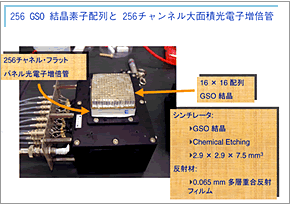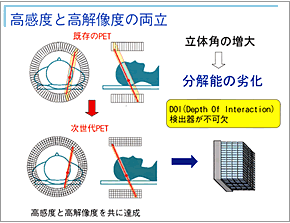NIRS NEWS No.75, JAN 2003
Development of a 3D Radiation Detector for the Next Generation PET
Hideo Murayama
The next generation PET team at NIRS has developed a four-layer DOI detector, for the first time, which achieves both a high resolution and a high sensitivity at the same time. The team consists of NIRS, Chiba Univ., Tokyo Inst. of Tech., Univ. of Tokyo, Kitasato Univ., Rikkyo Univ., Tsukuba Univ., Kobe City Coll. of Tech., Hitachi Chemical Co., Shimadzu Co, and HAMAMATSU.

The 256 x 4 GSO crystals array and the 256ch position sensitive PMT |
|---|
The four layers are identified by a combination of a pulse-shape-discrimination method and a light sharing method; deferent concentration of Ce in GSO crystals output deferent temporal waveforms, and reflectors inserted between crystals guide the light in certain paths. Compared with a conventional 3D PET, the sensitivity increases three times, and the spacial resolution is improved from 5 mm to 3 mm. This paper has been read in IEEE Nuclear Science Symposium and Medical Imaging Conference, Norfolk, U.S.A., Nov. 10-16, 2002.
 Fig: Achieving both a high sensitivity and a high spacial resolution. |
|---|
In future, the electronics will be improved by employing application specific integrated circuits (ASICs) for real-time measurements. A close teamwork with medical doctors, pharmacist, biologist, etc., is required.

